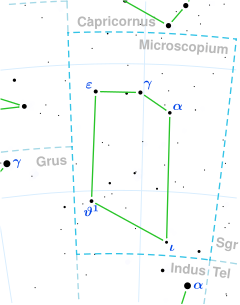현미경자리 세타1
Theta1 Microscopii| 관측 데이터 에폭 J2000 이쿼녹스 J2000 | |
|---|---|
| 별자리 | 현미경 |
| 우측 상승 | 21h 20m 45.62633s[1] |
| 탈위임 | −40° 48′ 34.3607″[1] |
| 겉보기 크기 (V) | 4.82[2] |
| 특성. | |
| 스펙트럼형 | A7VpSrCrEu[3] |
| U-B색지수 | -0.07[2] |
| B-V색지수 | +0.02[2] |
| 변수형 | α2 CVn[4] |
| 아스트로메트리 | |
| 방사 속도 (Rv) | +2.30km[5]/s |
| 고유 운동 (μ) | RA: +75.168mas[1]/yr Dec.: +8.657[1]mas/yr |
| 시차 (π) | 18.2678 ± 0.5314[1] 마스 |
| 거리 | 179 ± 5 리 (55 ± 2 pc) |
| 절대치수 (MV) | 1.03[6] |
| 세부사항[7] | |
| 미사 | 2.32+0.18 −0.26 M☉ |
| 반지름 | 2.35±0.34 R☉ |
| 루미도 | 36.3+8.4 −6.8 L☉ |
| 표면 중력 (log g) | 4.06±0.12 cgs |
| 온도 | 9,240±480 K |
| 금속성 [Fe/H] | 0.00[8] 덱스 |
| 회전 속도 (v sin i) | 43.7±1.7km/s |
| 나이 | 437±209 마이어 |
| 기타 지정 | |
| 데이터베이스 참조 | |
| 심바드 | 자료 |
θ1 현미경(Cymicopii)은 테타 현미경(Teta1 Micromicopiii)으로 라틴어화된 것으로, 미시시피움 남쪽 별자리에 있는 것으로 추정되는 2진[10] 별 체계다.육안으로 볼 수 있는 것은 시력이 4.82로 보이는 희미한 백색 광점이었다.[2]이 시스템까지의 거리는 시차 기준으로 대략 179광년이다.[1]
1차 항성은 기간 2.125일, 규모 4.77~4.87인 α2 CVn 변수뿐 아니라 스펙트럼에 금속선이 강한 화학적으로 특이한 별인 Ap 별이다.[4][3][6]A7VpSrCrEu의 별 분류를 가진 A형 주계열성으로,[3] 접미사 표기법은 스트론튬, 크롬, 유로피움의 풍부 이상 징후를 나타낸다.이 별은 4억3700만년 된 것으로 태양 질량의 2.3배, 태양의 반지름의 2.4배에 이른다.유효온도 9,240K로 광권으로부터 태양의 36배에 달하는 광도를 방출하고 있다.[7]
동반성은 2018년 현재 46°의 위치 각도를 따라 1차로부터 0.10°의 각이 분리되어 있는 진도 7.42의 항성이다.[11]
참조
- ^ a b c d e f Brown, A. G. A.; et al. (Gaia collaboration) (August 2018). "Gaia Data Release 2: Summary of the contents and survey properties". Astronomy & Astrophysics. 616. A1. arXiv:1804.09365. Bibcode:2018A&A...616A...1G. doi:10.1051/0004-6361/201833051.이 소스에 대한 가이아 DR2 기록 VizieR.
- ^ a b c d Ducati, J. R. (2002). "VizieR Online Data Catalog: Catalogue of Stellar Photometry in Johnson's 11-color system". CDS/ADC Collection of Electronic Catalogues. 2237. Bibcode:2002yCat.2237....0D.
- ^ a b c Abt, Helmut A.; Morrell, Nidia I. (1995). "The Relation between Rotational Velocities and Spectral Peculiarities among A-Type Stars". Astrophysical Journal Supplement. 99: 135. Bibcode:1995ApJS...99..135A. doi:10.1086/192182.
- ^ a b Watson, C. L. (2006). The International Variable Star Index (VSX). The Society for Astronomical Sciences 25th Annual Symposium on Telescope Science. Held May 23–25. Vol. 25. p. 47. Bibcode:2006SASS...25...47W.
- ^ Wilson, R. E. (1953). "General Catalogue of Stellar Radial Velocities". Carnegie Institute Washington D.C. Publication. Carnegie Institution of Washington. Bibcode:1953GCRV..C......0W. ISBN 9780598216885. LCCN 54001336.
- ^ a b Anderson, E.; Francis, Ch. (2012). "XHIP: An extended hipparcos compilation". Astronomy Letters. 38 (5): 331. arXiv:1108.4971. Bibcode:2012AstL...38..331A. doi:10.1134/S1063773712050015. S2CID 119257644. Vizier 카탈로그 항목
- ^ a b Sikora, J.; et al. (February 2019). "A Volume-Limited Survey of mCP Stars Within 100pc I: Fundamental Parameters and Chemical Abundances". Monthly Notices of the Royal Astronomical Society. 483 (2): 2300–2324. arXiv:1811.05633. Bibcode:2019MNRAS.483.2300S. doi:10.1093/mnras/sty3105. S2CID 119089236.
- ^ Gontcharov, G. A. (2012). "Dependence of kinematics on the age of stars in the solar neighborhood". Astronomy Letters. 38 (12): 771–782. arXiv:1606.08814. Bibcode:2012AstL...38..771G. doi:10.1134/S1063773712120031. S2CID 118345778. Vizier 카탈로그 항목
- ^ "tet01 Mic". SIMBAD. Centre de données astronomiques de Strasbourg. Retrieved 2019-09-03.
{{cite web}}: CS1 maint : 포스트스크립트(링크) - ^ Eggleton, P. P.; Tokovinin, A. A. (September 2008). "A catalogue of multiplicity among bright stellar systems". Monthly Notices of the Royal Astronomical Society. 389 (2): 869–879. arXiv:0806.2878. Bibcode:2008MNRAS.389..869E. doi:10.1111/j.1365-2966.2008.13596.x. S2CID 14878976.
- ^ Mason, B. D.; et al. (2014). "The Washington Visual Double Star Catalog". The Astronomical Journal. 122 (6): 3466. Bibcode:2001AJ....122.3466M. doi:10.1086/323920.



